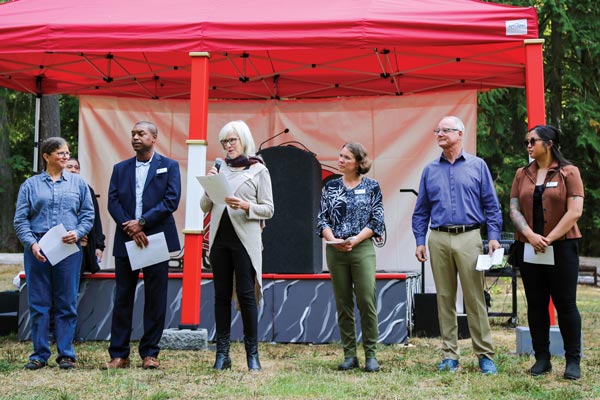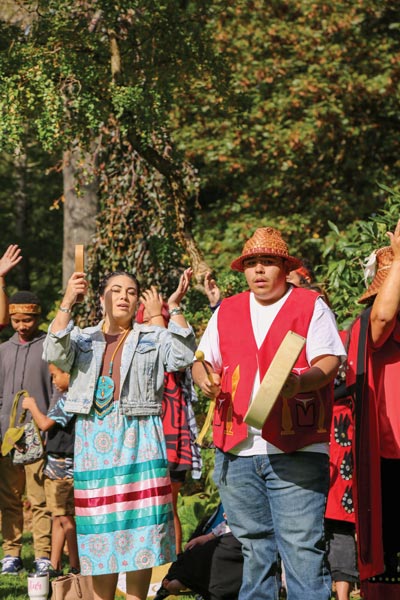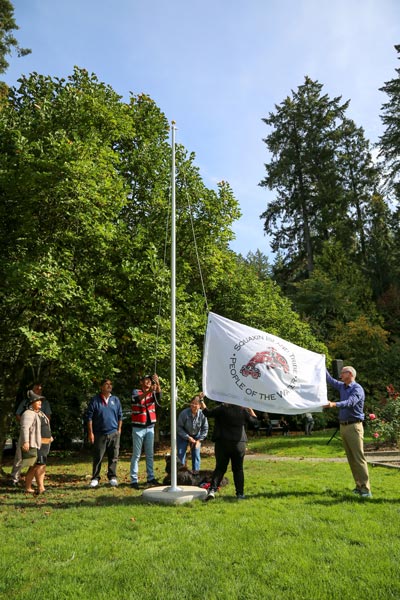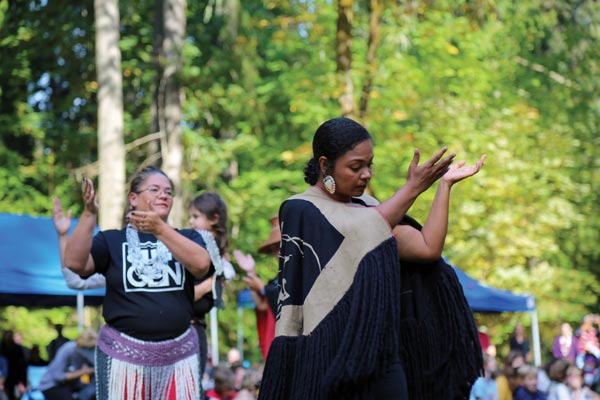by
<a href="mailto:communicationsteam@awcnet.org">Communications</a> | Jun 16, 2023
The gravitas of one city’s decision to rename its signature municipal park.
By: Ted Katauskas
The gravitas of one city’s decision to rename its signature municipal park
In 1848, a group of Catholic priests arrived on the eastern shore of Ellis Cove in southern Puget Sound and established a mission on 254 acres that for thousands of years had been inhabited by the Steh-Chass people of the Squaxin Island. The missionaries decamped in 1860, a year after the incorporation of the City of Olympia, and the property, which was acquired by a group of investors, remained unimproved until 1905 when the city purchased it for $1,200 (the equivalent of $40,200 today) and designated it Priest Point Park.
Fast forward more than a century, to April 2022, when Olympia’s City Council unanimously passed a resolution renaming Priest Point Park, the city’s largest municipal green space, Squaxin Park.
“The priests were only there for 12 years, and you look at their impact versus all the millennia that the tribes had been there, and you start to reevaluate. That was the driving force behind the renaming,” explains Olympia Parks, Art & Recreation Director Paul Simmons (he/him). “We didn’t just take off the old name and change all the signs. … The mayor led an effort with the Tribal Council to renew an accord, which basically dictates how our two governments work together. It was that foundational relationship piece that set things in motion.”
Before Mayor Cheryl Selby took office in November 2015, the Squaxin Island Tribal Council and Olympia City Council had been meeting together annually, as a ceremonial gesture of goodwill.
“Those meetings felt awkward because we really didn’t have enough of a foundation of trust,” explains Selby (she/her). “It felt like we were just checking a box. It was transactional, but there weren’t any transactions happening.”

Left to right: Olympia City Councilmembers Lisa Parshley and Dontae Payne, Mayor Cheryl Selby, Councilmember Dani Madrone, Mayor Pro Tem Clark Gilman, and Councilmember Yến Huỳnh present an Indigenous Peoples' Day proclamation at Squaxin Park on October 10, 2022.
So, in 2015 the two councils signed an official memorandum of understanding (MOU), vowing to work together. Five years passed, but not much changed. (As Mayor Selby says, “progress moves at the speed of trust.”) Following the signing of a second accord in April 2021, the flag of the Squaxin Island Tribe was raised over city hall.
“I am so grateful to the City of Olympia for this monumental gesture,” said Squaxin Island Tribal Chairman Kris Peters. “The flag is an acknowledgment of the original inhabitants of this area who stewarded these lands and waters since time immemorial and who are still here today. The MOU is an acknowledgment and working agreement between two sovereigns who are partners.”
Putting that agreement into action, in December 2021, the Squaxin Island Tribal Council passed a resolution asking Olympia to rename Priest Point Park as Squaxin Park. After a public hearing, Olympia’s Council approved the renaming four months later. On Indigenous Peoples’ Day last October, the two councils—with hundreds of residents and tribal members and busloads of schoolchildren—gathered in Squaxin Park for a formal rededication. Traditional drumming and dancing in Squaxin regalia and singing in the tribe’s Puget Salish language followed the unveiling of a new sign and a new name rendered in English and Lushootseed.

Members of the Squaxin Island Tribe perform traditional drumming and song at the Indigenous Peoples' Day gathering at Squaxin Park
As Kris Peters recalled that day in a documentary video produced by the city: “I grew up in Olympia, I’ve been a community member my whole life. When I visit the park and I sit here, I feel my ancestors. I drove in and I looked at the sign and it said, ‘Squaxin Park,’ I almost cried.”
“I was genuinely moved by the response of Chairman Peters and how meaningful this has been for the tribe,” adds Paul Simmons. “And to be part of that process, even if my role was small, I would consider that a highlight of my entire career; when I’m done, these are the moments I will cherish, when we are truly making an impact.”
Olympia’s mayor echoes that sentiment.
“I get emotional just thinking about that day,” she recalls. “Looking out in the crowd and seeing the young tribal members who’ve probably never seen themselves represented in this way in Olympia, I thought, ‘Now here’s this place that now has their name on it as recognition that they belong here.’”
“Looking out in the crowd and seeing the young tribal members who’ve probably never seen themselves represented in this way in Olympia, I thought, ‘Now here’s this place that now has their name on it as recognition that they belong here.’”

Squaxin Island Tribal Council Vice Chair Jaimie Cruz (black hat), Squaxin Island Tribal Council Member Vince Henry (red vest) and Olympia Mayor Pro Tem Clark Gilman (holding flag) raise the tribal flag at Squaxin Park during the Indigenous Peoples' Day park gathering.
Sylvana Niehuser, Olympia’s Parks, Planning and Maintenance director, took her son out of school to attend the celebration.
“It was really important for him, and for me, to be part of that celebration,” says Niehuser (she/her), who was instrumental in shepherding the renaming process for the city and the tribe. “I was feeling kind of misty-eyed the whole time because it was so moving and touching. I was proud not only to be a resident of Olympia but also to work for the city and to know that we were making progress. All the DEIB work I’ve been involved with comes back to relationships. When you start to build those authentic relationships, that’s when progress starts to happen.”
At the speed of trust.

Members of the Squaxin Island Tribe perform traditional dance at the Squaxin Park Indigenous Peoples' Day gathering.